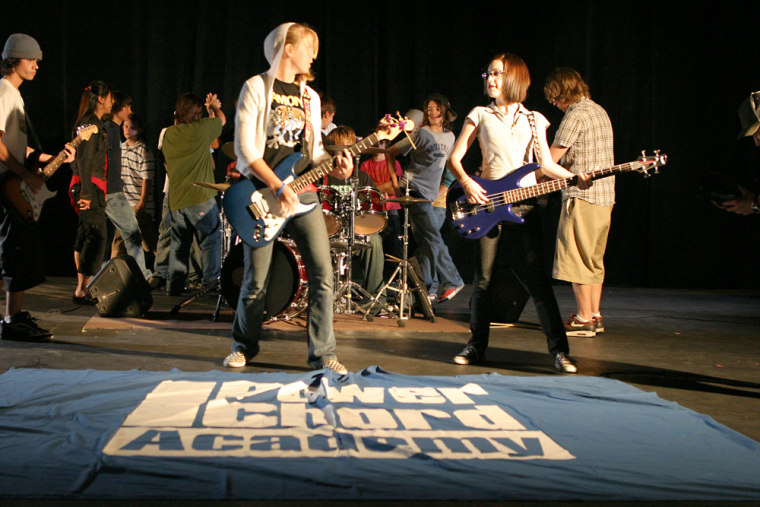Bedrolls, bug spray, teary good-byes alongside chartered school buses — while many summer campers head off to the same seasonal experience their parents, grandparents and great-grandparents had before them, a growing number are collecting memories of an entirely different nature.
"There is not a region or demographic we haven’t struck a chord with," says Samantha Franklin, regarding the widespread appeal of Power Chord Academy, a rock-and-roll fantasy camp.
Little wonder. Instead of being assigned to bunkhouses, these happy campers are assigned to bands. Absent a campfire, they gather around a sound stage and only figuratively ‘pitch a tent,’ retiring instead to a college dorm. And when they return home it is not with faint remnants of a rash, sunburn or lumpy pottery, but with professionally recorded and produced CDs and music videos.
“We immerse the kids in all aspects of music creation. Expose them to career opportunities in the industry all while introducing them to the college experience, schools with good music programs and opportunities for internships,” adds spokesperson Franklin, summarizing the camp’s well-focused goals.
But whether it’s a week of jamming or cramming to finish computer code for a new video game, a camp now exists for indulging any interest or fantasy-life a child might harbor. Where in the past camp activities were almost incidental, today, they are even becoming more individualized at camps involving wilderness and a lack of plumbing.
“Today, instead of everyone being subjected to the same activities program, campers have more opportunity to pursue things they are passionate about,” says Barry (B-Dawg) Vigon, camp director for Pali Overnight Adventures in Los Angeles and a 30-year camp industry veteran.
“There is also more emphasis on the ‘wow’ factor,” adds Andy Wexler, Pali’s founder.
Pali excites its little campers with one-week sessions of Secret Agent Camp, Hollywood Stuntman Camp, Circus Camp and even Broadcast Journalism Camp, among others.
Such specialization obviously comes at a much higher cost — the counselors at Pali’s Culinary Institute Camp, for example, are all highly regarded professional chefs. At Power Chord, staff members are required to be music-industry professionals. Even Franklin, the public relations coordinator, is in a band and has touring experience. All this expertise comes at a compensation level far exceeding what the traditional teenage camp counselor used to receive.
While participating in a campfire-lit round of Kumbaya can still be had for as little as $75 a week according to the Indianapolis-based American Camp Association (ACA), learning to design fashions worthy of Chanel at Fashion Camp or being immersed in Inca culture during travel camp to South America costs a bit more.
Yet, even at $1,500 plus per week, Power Chord’s attendance is growing exponentially, reports Franklin, adding that the camp added three more cities this year. Power Chord now holds multiple sessions in seven cities nationally throughout the summer. Pali is also at the high range of fees, but there is chance for payback: Its acting camp ends with an audition before a Hollywood agent.
Employing 1.2 million adults, the $20 billion camp industry is made up of approximately 12,000 organized camps in the U.S., according to Peg Smith, ACA executive director. That number would more than double if all the public-school programs now calling themselves ‘camps’ were included.
Smith further estimates 10 million kids will attend those camps this summer. “The industry is becoming more competitive, but with 55 million kids out there, there is still room to grow.”
And as the menu of experiences has expanded, many camp sessions have shortened, allowing attendance at multiple sessions throughout the summer, a trend which should further fuel industry growth. What may seem like over scheduling a child’s summer may reflect the growing need for supervision in families lacking a stay-at-home parent or full-time nanny.
“Twenty and thirty years ago parents were more comfortable letting kids roam the neighborhood from morning until dinner. Today they want their kids supervised,” says Wexler, and preferably supervised in a learning environment.
Campers at any age
Another trend is that camps are not just for kids anymore.
“Many camps use the shoulder seasons — immediately before and after their summer sessions — for their 'family' camps,” says Smith.
While the ‘wow’ factor is a clear trend in the industry, the fastest growing camp category is actually family camp. This segment has increased 215 percent over the last fifteen years.
Also growing in interest are adult-only sessions and sessions designed for seniors. ACA estimates adult campers number about million strong. While general camp enrollment is growing steadily at 1 to 3 percent annually, the growth in adult campers is 10-13 percent.
While service organizations like the Boy Scouts and religiously-affiliated camps still dominate —an estimated 8,000 camps are owned by non-profits — the ownership of for-profit camps is also evolving and growing.
“It is becoming more entrepreneurial. Many are doctors and lawyers who have left their careers to establish organized camps as a way of providing services to youths and connecting them to one another, nature and their emotions,” says Smith.
“This is what makes the camp experience so highly valued,” she adds, and what edges enrollments higher each year. “It is a primary experience that engages all the senses, complementing the formal educational process. It also recaptures a sense of community. The kids are able to engage in activities across an environment in relative safety.” Whether that involves spending a few hours at a swimming hole or learning how to silkscreen, campers experience a freedom of movement in a secure place.
And regardless of the kind of camp they attend or how much it costs, ACA research finds the majority of campers still return home talking about the same thing their parents and grandparents did before them — all the new friends they made while they were off exploring the world. And having no doubt about what they want to do next year.
